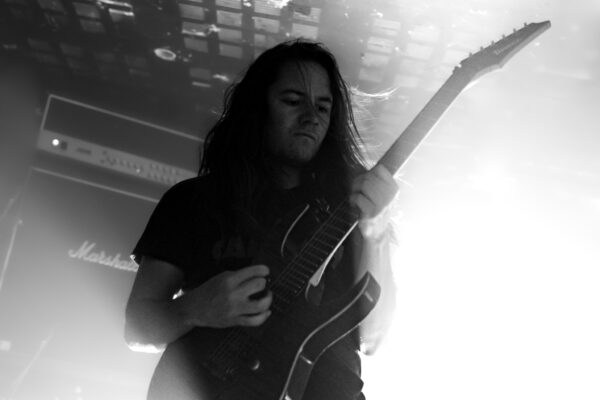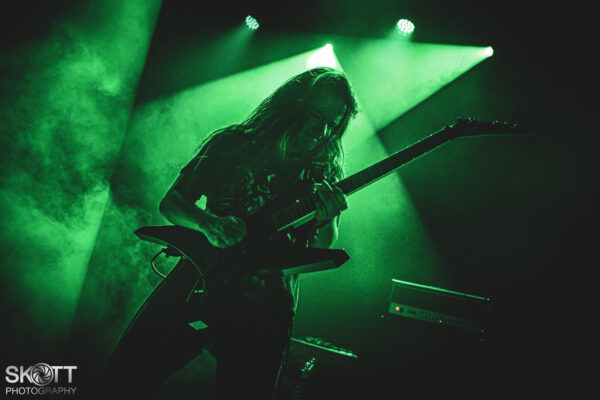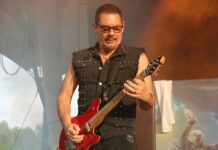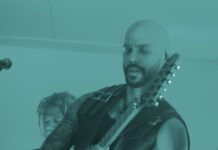This article series is about the tools of popular guitarists. What are their favorite guitars and how is it related to them? This time with Adrian Utzon Dietz (Spade, ex-Solbrud).

Credit_Linda Gabor
When you start guitar playing and do you remember your first guitar?
It was early 2006 at the age of 18. I was finishing high school and had gotten more and more into rock, punk and heavy music throughout my teenage years. One day I visited a friend and he taught me Come As You Are (what else?) on his acoustic. Around the same time I downloaded some guitar videos with Adrian Smith and with Daron Malakian for some guitar magazine – I went down our basement and found my dads old 60’s Höfner, started out with some tabs and was hooked from that moment.
I also remember the „even nicer“ guitar that was on the wall that day, which I wanted more but was a little too expensive in case I wouldn’t keep playing. It was an Ibanez SZ4020 which went out of production shortly after. But a while back I decided to track one down and get it, since I was still playing alot after all this time. Awesome guitar.
What are your influences and which guitar players are your faves?
There has got to be quite a few that I’ve picked up stuff from over the years. I am a rock and blues player by heart and especially British rock from right around the 70’s I consider to be the most amazing music there is. My heroes and inspirations include especially Tony Iommi, Peter Green, Eric Clapton, Brian May, Michael Schenker, Andrew Latimer.

Enough … and then some. It must be around 15 if I include acoustics, lap steel, zither and sitar. I started out on Ibanez RG’s, so I am partial to a fairly light and thin body and a slim neck that’s not too narrow, which is why I prefer an SG over a Les Paul too for example. All my electrics (except for a Jackson Warrior that has active EMG’s) feature two passive humbucker pickups, so that’s my game.What do you think makes the perfect guitar and amp?
That would always depend on what I want to achieve, but I can attest that a Gibson through a Marshall works well, and that is what I am currently playing for blues rock. I like to keep things simple yet versatile, so I go for a rich, full and crisp clean tone and feed that with a good overdrive of some kind, while keeping other effects to a minimum. Since my early days as a player I have been fascinated by seeing really good blues guitarists control their tone using just the knobs on the guitar and the way they play it.

How do you feel about the question of modeler or tube amp?
For a handful of years I have used a small Fender Mustang GT modeling amp at home to track guitars for my demos, using the stereo output directly to my sound interface. I have to admit it works very well for me and sometimes I even find myself struggling to replicate or improve the sounds on my big amps and proper microphones down in my recording setup. I can certainly see the potential and practicality in modeling both in terms of studio and live situations and it looks like that’s where the future lies, but in both cases, I myself prefer having a big ass stack standing behind me and I know so many of us are purists that swear to high level vintage gear.
Which guitars and amps were used on the new album or for recordings?
On the latest Solbrud album – ‚IIII‘ – I used mostly my three Ibanez axes and my Jackson Warrior for a few of the lead parts. I tracked one set of rhythm guitars on my Marshall JVM210H and another set of rhythm guitars on my ’71 Laney Super Group, with just two different distortion pedals between guitar and amp. Both drove 4×12″ cabinets with two microphones on each. For all the lead parts I played both amps simultaneously, louder and with a bit more gain, some reverb and delay, and then I double tracked everything or even triple or quadruple tracked some things that were harmonies, so our producer would end up having to mix in 16 lead tracks down with 16 or more Rhythm guitar tracks, same amount of drum tracks, and so on. Anyways, that lead sound in the room is the best sound I have had to work with. As you may know, a 100 watt Laney Super Group can play ridiculously loud and when it does it sounds incredible. I had it clocked in around 6 or 7 and I was standing in the same room, which was literally shaking and things were falling down from tables as I was working. A bit scary at first, but highly inspirational. I kept jamming and coming up with new riffs along the way, because the sound was so good to play with, and although I may have nailed a lead part, I just kept playing on and on because I didn’t feel like stopping at all. It’s a fairly orchestrated album so you’ll also hear my hand-built western and classical guitars, my old Framus 12-string and even my zither being used quite extensively in the acoustic passages.

credit: Martin Dam Kristensen
When you only can choose one guitar, which one will you take?
I’ll take my Gibson SG with me to my grave when it is time for me to ascend for more lessons and jams beyond.














